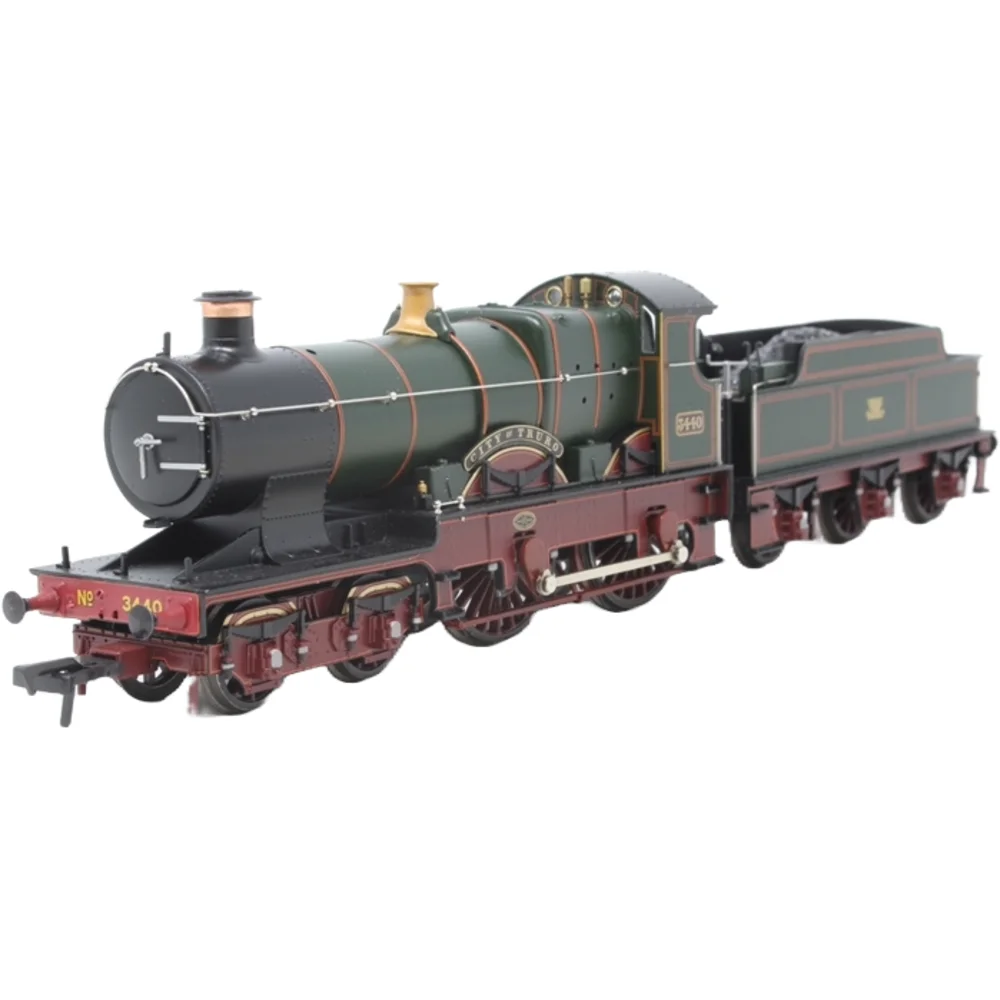Bachmann 31-725NRMB
Great Western Railway 3700 3717 "City Of Truro" Great Western Railway Lined Green with Crest
Tooling
The Bachmann tooling for the GWR 3700 (City) Class was launched in 2009, bringing to life one of the most iconic express passenger locomotives of the Edwardian era. Designed by Churchward and famed for the legendary 3440 City of Truro—allegedly the first steam locomotive to reach 100mph—the City Class represented a pivotal shift in GWR locomotive design. Bachmann’s model captures the elegance and engineering innovation of the original 4-4-0 locomotives, making it a centrepiece for pre-grouping and early Big Four layouts.
Tooling Features
- Construction: Plastic and metal chassis
- Couplings: NEM pockets with tension lock couplers
- Minimum Radius: Radius 2 curves
- Sprung Buffers: Present on both locomotive and tender
- Opening Smokebox Door: Cosmetic working feature
- Detailing: Factory-fitted handrails, lamp irons, safety valve, smokebox dart, tender handbrakes, toolboxes, water scoop, whistle
- Additional Pack: Footsteps, lamps, bufferbeam detail, pipework, guard irons, vacuum pipes
- Cab Interior: Painted and glazed with fallplate
Mechanical & Electrical
- Motor: 3-pole motor located in the locomotive
- Drive: Loco-driven (2 powered wheels)
- Pickups: All wheels
- Power Collection: 2-rail DC
- Weighting: Within boiler for improved adhesion
DCC Capability
- DCC Ready: 21-pin socket located in the tender
- Speaker Provision: No factory provision, but space available in tender for user installation
Liveries Produced
- GWR Green (e.g. City of Truro, City of London)
- WWI Khaki (e.g. City of Birmingham in Ambulance Train Pack)
Reviews & Commentary
Initial reviews praised the model’s fidelity to prototype, especially the elegant proportions and fine detailing. The tooling was noted for its smooth running and visual appeal, particularly the outside frame rods and cams. Some users have commented on the tight internal clearances, which can make DCC sound and lighting upgrades challenging without modification. Nevertheless, the model remains a favourite among enthusiasts for its historical significance and aesthetic charm.
Social Media & Community Feedback
On platforms like YouTube and model forums, the City Class tooling has been celebrated for its nostalgic value and mechanical beauty. Custom sound projects—such as those using YouChoos decoders—have added immersive realism, with authentic whistle recordings from preserved runs of City of Truro. Community posts often highlight the model’s suitability for pre-grouping layouts and its role in commemorating early high-speed steam achievements.
Interesting Notes
- The tooling includes a permanently coupled tender housing the DCC socket and PCB.
- Opening the body requires careful screw removal from the baseplate and tender footplate.
- Etched nameplates and numbers are included but require user fitting.
Whether you're a GWR historian or a modeller seeking Edwardian elegance, Bachmann’s City Class tooling offers a compelling blend of visual appeal and engineering fidelity.
Class & Prototype
- Class: Great Western Railway 3700
- Traction: Steam
- Built: 1902-1909
- Total Built: 20
No prototype found.
Operator & Livery
- Operator: Great Western Railway
- Livery: Lined Green with Crest
The Great Western Railway (1835-1947) was Britain's most innovative railway company, engineered by Isambard Kingdom Brunel with his revolutionary 7ft ¼in broad gauge system. Known affectionately as "God's Wonderful Railway" and the "Holiday Line," the GWR connected London Paddington with the West Country, Wales, and Birmingham through 3,800 miles of superbly engineered routes.
Renowned for its Brunswick green locomotives, chocolate and cream carriages, and engineering excellence centred at Swindon Works, the GWR pioneered advanced steam technology under chief mechanical engineers Daniel Gooch, George Jackson Churchward, and Charles Collett. The company's legendary locomotive classes—including Castle, King, Hall, and Manor—established performance standards that influenced British locomotive design for decades.
The only "Big Four" railway to retain its original identity through the 1921 grouping, the GWR maintained its distinctive corporate culture until nationalisation in 1947. Today, the company's engineering legacy lives on through extensive preservation efforts, heritage railways, and detailed model railway recreations that celebrate the finest traditions of British steam railway operation.
The GWR Lined Green with GW Crest livery represents the final evolution of Great Western Railway locomotive decoration, introduced in late 1934 and used until nationalisation in 1947. This dignified livery featured the company's distinctive Middle Chrome Green body colour with elegant orange and black lining, distinguished by the iconic "twin shield" crest displaying the coats of arms of London and Bristol side by side.
This livery replaced the earlier "shirt button" roundel branding and marked a return to heraldic insignia reflecting the GWR's founding purpose—linking the two great cities. The twin shield crest featured the arms of the City of London (St George's Cross with ceremonial sword) alongside the City of Bristol (ship and castle), symbolising the railway's role as the premier connection between the capital and the west.
Applied to all passenger and mixed-traffic locomotive classes including Castle, King, Hall, Manor, and Grange classes, this livery survived wartime austerity when most locomotives received unlined black paint. The finest examples continued to receive full lined green treatment throughout the Second World War, maintaining the GWR's reputation for locomotive presentation excellence until the company's final days in 1947.
Modelling Note: This livery is accurately represented by manufacturers including Hornby, Bachmann, and Graham Farish, with Fox Transfers providing authentic twin shield crest decals (reference FRH4104) for detailed restoration work.
